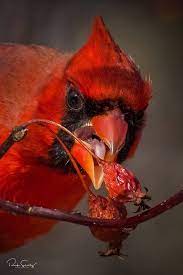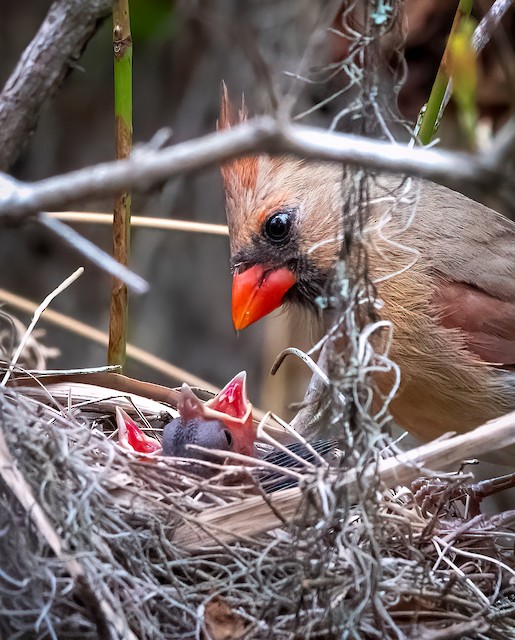Look for Northern Cardinals in dense shrubby areas such as forest edges, overgrown fields, hedgerows, backyards, marshy thickets, mesquite, regrowing forest, and ornamental landscaping. Cardinals nest in dense foliage and look for conspicuous, fairly high perches for singing. Growth of towns and suburbs across eastern North America has helped the cardinal expand its range northward.

Northern Cardinals eat mainly seeds and fruit, supplementing these with insects (and feeding nestlings mostly insects). Common fruits and seeds include dogwood, wild grape, buckwheat, grasses, sedges, mulberry, hackberry, blackberry, sumac, tulip-tree, and corn. Cardinals eat many kinds of birdseed, particularly black oil sunflower seed. They also eat beetles, crickets, katydids, leafhoppers, cicadas, flies, centipedes, spiders, butterflies, and moths.

A week or two before the female starts building, she starts to visit possible nest sites with the male following along. The pair call back and forth and hold nesting material in their bills as they assess each site. Nests tend to be wedged into a fork of small branches in a sapling, shrub, or vine tangle, 1-15 feet high and hidden in dense foliage. They use many kinds of trees and shrubs, including dogwood, honeysuckle, hawthorn, grape, redcedar, spruce, pines, hemlock, rose bushes, blackberry brambles, elms, sugar maples, and box elders.

Northern Cardinals hop through low branches and forage on or near the ground. Cardinals commonly sing and preen from a high branch of a shrub. The distinctive crest can be raised and pointed when agitated or lowered and barely visible while resting. You typically see cardinals moving around in pairs during the breeding season, but in fall and winter they can form fairly large flocks of a dozen to several dozen birds. During foraging, young birds give way to adults and females tend to give way to males. Cardinals sometimes forage with other species, including Dark-eyed Juncos, White-throated Sparrows, other sparrow species, Tufted Titmice, goldfinches, and Pyrrhuloxias. They fly somewhat reluctantly on their short, round wings, taking short trips between thickets while foraging. Pairs may stay together throughout winter, but up to 20 percent of pairs split up by the next season.

The expansion of agricultural and suburban habitat over the last two centuries has been good for Northern Cardinals which are abundant in eastern and central North America. According to the North American Breeding Bird Survey, their numbers have increased by an estimated 0.32% per year since 1966. Partners in Flight estimates a global breeding population of 130 million and rates them 5 out of 20 on the Continental Concern Score, indicating a species of low conservation concern.